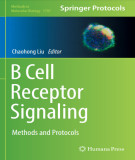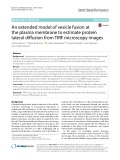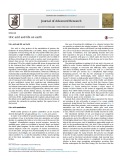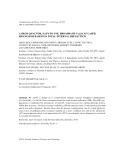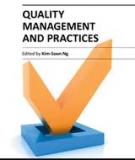
Total internal reflection
-
Ebook "B cell receptor signaling: Methods and protocols" looks the current advanced protocols used to study aspects of the B cell receptor (BCR). The chapters in this book cover topics such as the mutant of BCR repertoire to understand antibody evolution; interactions between B cells and viruses; mechanical force during BCR activation; B cell signaling using flow cytometry; confocal microscopy, total internal reflection microscopy and intravital two-photon microscopy;...
 262p
262p  lucchinguyen
lucchinguyen
 28-12-2023
28-12-2023
 5
5
 2
2
 Download
Download
-
Characterizing membrane dynamics is a key issue to understand cell exchanges with the extra-cellular medium. Total internal reflection fluorescence microscopy (TIRFM) is well suited to focus on the late steps of exocytosis at the plasma membrane.
 10p
10p  viflorida2711
viflorida2711
 30-10-2020
30-10-2020
 18
18
 1
1
 Download
Download
-
Uric acid is a key product of the metabolism of purines, the backbone of Desoxyribonucleic acid (DNA). Being a fundamental component of every living cell, the total Earth’s DNA base pairs is estimated to weigh 50 billion tons [1], which translates into a huge abundance of uric acid in our planet. It would be naive to think of all these virtual heaps of uric acid as useless, inert waste produces. Indeed, they are not. Uric acid in the environment is a rich source of nitrogen (33% of its weight) to plant life, hence its important role in the universal food chain.
 4p
4p  trinhthamhodang1
trinhthamhodang1
 14-11-2019
14-11-2019
 13
13
 0
0
 Download
Download
-
Results show that the present configuration can be a high Q-factor, easy-to-use, broadband prism resonator suitable as a laser oscillator not only in the ultraviolet (UV) region but also down to vacuum ultraviolet (VUV) wavelengths where alignment is restricted to vacuum environments.
 6p
6p  thuyliebe
thuyliebe
 08-10-2018
08-10-2018
 27
27
 1
1
 Download
Download
-
These publications—international journals as well as niche and regional scholarly publications—were collectively responsible for 1 million manuscript submissions in 2010 (1.2 million in 2011). In 2005, the total number of submissions made using ScholarOne Manuscripts was 317,325. The data have not been normalized to reflect the growing number of sites using ScholarOne Manuscripts. The trend from clients has been initially to debut larger sites, usually in Science, Technical and Medical (STM) subjects, and then move to smaller titles, often in non-STM fields (see Figure 1).
 8p
8p  docvachiase
docvachiase
 03-05-2013
03-05-2013
 30
30
 2
2
 Download
Download
-
Final figures have been projected to reflect international statistics and are exclusively based on the estimated number of Plastic Surgeons in each country and the responding sample. Whereas the U.S.‐ based study funded by the American Society of Aesthetic Plastic Surgery includes Board Certified Plastic Surgeons, Dermatologists, and Otolaryngologists, this International Survey is focused entirely on board certified (or national equivalent) Plastic Surgeons.
 25p
25p  giamdocamnhac
giamdocamnhac
 06-04-2013
06-04-2013
 66
66
 3
3
 Download
Download
-
This book is comprised of a collection of reviews and research works from international professionals from various parts of the world. A practical approach to quality management provides the reader with the understanding of basic to total quality practices in organizations, reflecting a systematic coverage of topics. Its main focus is on quality management practices in organization and dealing with specific total quality practices to quality management systems.
 264p
264p  bi_bi1
bi_bi1
 11-07-2012
11-07-2012
 143
143
 35
35
 Download
Download
-
Assessment of Circulating (Visceral) Proteins The serum proteins most used to assess nutritional status include albumin, total iron-binding capacity (or transferrin), thyroxine-binding prealbumin (or transthyretin), and retinol-binding protein. Because they have differing synthesis rates and half-lives—the half-life of serum albumin is about 21 days whereas those of prealbumin and retinol-binding protein are about 2 days and 12 h, respectively—some of these proteins reflect changes in nutritional status more quickly than others.
 6p
6p  konheokonmummim
konheokonmummim
 03-12-2010
03-12-2010
 68
68
 3
3
 Download
Download
-
Protein Catabolism The rate of endogenous protein breakdown (catabolism) to supply energy needs normally falls during uncomplicated energy deprivation. After about 10 days of total starvation, the unstressed individual loses about 12–18 g/d protein (equivalent to approximately 2 oz of muscle tissue or 2–3 g of nitrogen). By contrast, in injury and sepsis, protein breakdown accelerates in proportion to the degree of stress, to 30–60 g/d after elective surgery, 60–90 g/d with infection, 100–130 g/d with severe sepsis or skeletal trauma, and 175 g/d with major burns or head injuries.
 5p
5p  konheokonmummim
konheokonmummim
 03-12-2010
03-12-2010
 76
76
 3
3
 Download
Download
CHỦ ĐỀ BẠN MUỐN TÌM








